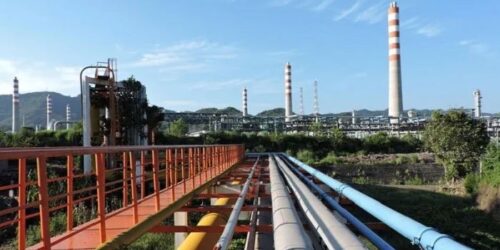In a landmark development, Pakistan and the Russian Federation on Friday signed the amended Inter Governmental Agreement for North South Gas Pipeline (NSGPP) of 1,122 kilometers from Port Qasim (Karachi) to Kasur (Punjab) that will increase the capacity of the country to transport the imported gas from the port city to load center of Punjab. According to a press release, Pakistan’s Ambassador to the Russian Federation, Shafqat Mahmood, signed the Protocol to the Inter Governmental Agreement (IGA) along with Nikolai Shulginov, Minister for Energy, Russian Federation, in Moscow.https://61bef715b487daa8191defa19fb5b36a.safeframe.googlesyndication.com/safeframe/1-0-38/html/container.html
The IGA has been updated as a protocol to reflect the utilization of GIDC (gas infrastructure development cess) and continued partnership with Russia to build the project. This has happened after successful negotiations conducted between Pakistan’s Ministry of Energy (Petroleum Division) and Russian Ministry of Energy. Under the amended agreement, the North-South Gas pipeline has been renamed as Pakistan Stream Gas Pipeline (PSGP) and to this effect a PSGP Special Purpose Vehicle (SPV) will be set up within 60 days of the signing of protocol, to implement the project and deal with all the technical and commercial issues.
The Pakistan Russia Inter Governmental Agreement (IGA) on North South Gas pipeline was earlier signed between both countries in 2015 but was not implemented. The project has been delayed since 2015 with no headway.
It is a flagship Pakistan Russian energy project which will enhance bilateral cooperation in the hydrocarbon sector between both countries and provide huge technological uplift and employment opportunities to local companies in Pakistan.
“Under the revised IGA, Pakistan will be having the major shareholding with 74 percent stakes in the Pakistan Stream Gas Pipeline (PSGP). And Russia will have 26 per cent equity.” As per the IGA signed in 2015, Russia had to build the gas pipeline project on its own, with 100 percent financing. Earlier, Russia was to build the pipeline based on the build, own, operate and transfer (BOOT) model, and had to transfer the ownership of the pipeline to Pakistan after 25 years. And in the previous model, Russia had to contribute 85 per cent of the required expenditure on the project whereas Pakistan had to spend 15 percent of the capital.
With this flagship project, Russia will increase its stakes in the Pakistan energy sector by helping build the PSGP. It is pertinent to mention that in the past, Russia helped Pakistan build Pakistan Steel Mills (PSM), and the country’s flagship organization in the oil and gas sector – OGDCL. Pakistan has in the recent past imported wheat from Russia to cater to its food requirements. Pakistan and Russia have already developed strategic partnership in the defence sector.
The cost of the Pakistan Stream Gas Pipeline has been estimated at $2.25 billion, which is yet to be finalized after input from Russian experts. The country’s existing system has the capacity to import and transport RLNG of 1.2 billion cubic feet. The country has two LNG terminals — one is owned by Engro and the other by the Pakistan Gas Port. Two more LNG terminals are being installed, one by Energas and second by Tabeer company. The new terminals will increase the country’s ability to import and re-gasify LNG by 1.2-1.5 bcfd. And there is no pipeline available to transport the RLNG within the country, which will be imported and re-gasified by new terminals. For transport of more RLNG, Pakistan badly needs the Pakistan Steam Gas Pipeline.
Pakistan is a highly gas deficit country. The local gas production has drastically dwindled to 3.2 bcfd from 4.2 bcfd and to meet the increasing deficit of 2.5 bcfd, the country is importing LNG of 1-1.2 bcfd, depending upon the needs of the country. In the winter season, the country’s demand increases manifold up to over 6 bcfd, which is not being met by local gas and imported LNG. Pakistan currently can import LNG of 1.2 bcfd but when two more LNG terminals come on stream, the capacity of the country to import LNG will increase up to 2.4 bcfd, which will help meet the growing gas deficit of the country.
Keeping in view the decreasing trend in local gas production, the projected gas deficit stands at 4 bcfd, which will also be met by the import of 1.35 bcfd gas from Turkmenistan under the TAPI project.







